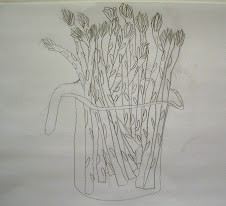
I've been thinking about some of the cliches associated with art, and contrasting them with lesser known realities. I was just reading
Kimberly Brooks blog about the creative process. (Ms. Brooks writes occasional pieces for the
Huffington Post.) In this particular blog she talks about having a large canvas sit blank in her studio for several weeks while she tried to summon the bravery to work on it. Finally, to overcome her fears, she randomly applies some bright colors to it. And this much, her "painter's block" and her emotional resolution of it are what many people today would identify as the essential character of creative endeavor. It is one of the cliches.
Cliches such as this one gain force by their repetition and by a generally lax approach to art education -- lax, I mean, on the part of artists. A little research independently done into the process behind truly great works of art reveals a very different sort of process.
To cite one example, the great British landscape painter
Joseph Mallord William Turner drew incessantly from childhood onwards. Once he seriously chose to become an artist, he as quickly began angling for ways to sell his works, inspired by his humble circumstances which made earning his keep an urgent necessity. And his marketing efforts found early success, not the least because even his early works showed a remarkable fluency with visual forms. In short, he practiced his art assiduously and became exceedingly skillful at it.
He also apparently felt a reluctance to tackle a large canvas, but for reasons quite different from those typical of today's artists, as Ms. Brook's piece relates. Canvas was expensive and Turner was loath to waste money on material resources. So his early works tend, for the most part, to be small drawings and watercolors. And it was only after Turner had become an accomplished creator of images that he even turned his attention to large painting, and did so for the money, the prestige, and probably also to demonstrate that his skills were as large as those of various famous masters (such as
Aelbert Cuyp). When Turner began his first large painting (and it was really large), he did not indulge a case of blocked creativity. Quite the contrary, he worked out the essential elements of the composition in drawings and other small images and then transferred the idea to the larger tableau. The creativity of the project did not reside in staring at a void and trying to imagine something, anything, with which to fill it. The creativity arose from having a motif, a subject, a particular landscape he wished to depict, and then blocking in the large forms of that image onto this new larger format.
His creativity certainly did not end there, as anyone familiar with the painter's works knows. Turner would eventually become renowned for his experimental uses of paint, imagery, and scale. Certainly in his first large scale works he would repeat ideas that had been first developed on a smaller scale. But the artist's sensitivity to the potentialities of scale would readily become a feature of monumental works. In short, he just painted.
The artists that we now call the old masters suffered fewer qualms about making images than do today's artists. They were not unwilling to just paint something. They were aware that, through making images, they were gaining not only sharpened skill, but were gaining experience, sensibility, and new ideas, ideas which they might store away for future things. They did not need to just fill the blank void with
anything in the hopes of getting an idea. They had specific aims in mind that they pursued. It's a good lesson for anyone trying to make art today, a lesson in humility as well as daring.














